On "the Tuesday after St. Nicholas' Day, A.D. 1492," Heinrich, Jacob and Johannes of Urikon were knighted at Einsideln, Canton of Zurich, by Frederic, Roman Emperor, whereupon they received a confirmation, "to them and their heirs, forever and ever" of the ancient coat of arms portrayed here. John S. Wurts, MAGNA CHARTA, 1954, Part VII, p. xiv. (which I have colorized, to the right)
On the following page of the book is a picture of a knight in armor upon, a charging horse rearing on its hind legs. The knight's helmet bears an angel praying, and on the breastplate of the horse is found the same shield pictured at right, with a caption,"On the fifteenth of November, 1315, the three sons of Albert von Uerikon: Rudolph, Berenger and Conrad who is pictured above, died in the Canton of Zurich, at the battle of Morgarten, between Duke Leopold of Austria and the Swiss Confederacy."
APPENDIX.
_________
"For the following additional and interesting historical facts
in relation to our family in ancient times, I am indebted to Herr
Caspar Wirz, whom I met in Zurich in 1885, and who was then
pastor of a church in Aadorf, in the canton of Zurich. He is a
descendant, but by a different line from ourselves, of our
ancestor, Johannes Conrad Wirz, who was born August 27,
1631.
Herr Caspar Wirz is a highly educated gentleman, and
greatly interested in the ancestral history of our family. His
connection with the public library of Zurich as one of its
directors, gives him free access to all the ancient archives of
that institution, and he has pursued his investigations with
great industry and intelligence.
C. P. W.
The Allemanic invasion of that portion of Switzerland east
of the Aar, impressed upon the country the feudal system, the
last vestiges of which did not disappear until after the French
Revolution. The feudal system is too well understood to require
a description here. The knights (Rittern) were the lower
nobility, and they were possessed of lands and castles
hereditary in title, as to the acquisition of some of which history
gives no clue, while others were the benefactions of kings,
princes and monasteries, bestowed for distinguished military or
other services.
According to perfectly authenticated records, the family
Wirz, as far back as the thirteenth century, is found among the
Rittern, or lower nobility, of Unterwalden. In the middle of that
century, all of the nobles, among them the Wirzen, were
banished from the Unterwalden
page 82
region. Some members of the family, which was not numerous at
that time, made their way to Lake Zurich, and took up their
residence at Erlenbach. Of these, some remained in their new
home ; but one or two returned to Unterwalden at the first
opportunity. The first member of the family whom we find
occupying a public position in Unterwalden after the removal of
the interdict, is Niclaus Wirz. He was Landamman, or President,
of the State, the highest official post in the government, from
1347 to 1350. Afterwards, Johannes Wirz held the same office
from 1353 to 1361.
Some of the family history of that period is gleaned from
land conveyances and other documents of a contract nature,
which, although they were never signed in written characters
(for few even of the nobles could write their names), were sealed
with the arms of the contracting parties. The arms of the first
Wirz in Erlenbach were the triangle and crosses, and, in all
probability, these were the arms of the family before its
expulsion from Unterwalden. One of the Wirzen of Erlenbach
married the only surviving member of the nobles of Uerikon,
who possessed a fief from Einsiedeln. This lady was heiress of
the titles and estates of the family at Uerikon. Hence the angel
arms* which were now used in the Uerikon branch. At
Erlenbach also, our ancestors had been invested with estates by
Einsiedeln and were Ammaner, or land-stewards, of that wealthy
and powerful monastery.
Johannes Wirz, Ammann of Einsiedeln at Erlenbach, and a
burgher, or citizen, of Zurich went to Unterwalden and there
became Landamman, an office which he held in 1396-7. Here he
married Elizabeth, heiress of the noble family of Rudenz, and
from that time used the arms of that family. This coat-of-arms is
used by the Wirz family in Unterwalden to this day.
If there were no other evidence of the fact, the high
position of the Wirz family in those days is abundantly proved
by the alliances with the families of Uerikon and
---------------------
*Red escutcheon with gold bars; crest, a praying angel.
page 83
Rudenz, for, by the law at that time, the daughters of noble
families could not contract valid marriages with men of inferior
rank.
The chronicles of the time show that the Wirzen at
Erlenbach, Uerikon and Unterwalden were descended from the
old Unterwalden stem and were nearly related, but the record in
places is fragmentary and leaves the parentage of some
individuals in doubt, although the inferences to be drawn
enable the direct line to be traced with a degree of accuracy
equal to that of any mediaeval history.
It appears that at this time Ulrich owned the Uerikon
estates, and a brother of his, perhaps Tekli, who is mentioned at
this date in connection with the triangle arms, was Amman at
Erlenbach. Johannes and Niclaus, also brothers, although
burghers of Zurich, were unable to content themselves there
and returned to their former home in Unterwalden. just at this
period there is much uncertainty as to the history of the family
at Unterwalden, a fact not much to be wondered at when it is
considered how few at that time possessed the art of writing.
For such records as we have, we are indebted to the relations
which the members of the family sustained to the government
of Zurich, and to the cloister of Einsiedeln, whose records of
important families were preserved with much care.
We find, now, at the beginning of the fifteenth century,
three lines, viz-: Wirz von Rudenz, with the Rudenz arms; Wirz
von Uerikon, with the angel crest, and Wirz von Stein, with
what we have called the triangle arms, having as its crest a
plume of peacock's feathers.
The " angel " Wirzen trace their descent in unbroken line
from Burkhardt Wirz, Amman at Uerikon from 1470 to 1479.
They also say that Burkhardt was the son of Niclaus, who came
to Zurich in 1383; but this is not certain. This line of Wirz has
made use of the arms with the angel crest from the beginning of
the fifteenth century, and the family is in existence at this day in
Zurich.
The American family belongs to the third line. It
page 84
seems that the later generations in Zurich have taken it for
granted that this line also was to be traced to Burkhardt through
Jacob, whom they have supposed to be his grandson. The only
ground for this supposition is the statement in the chronicles
that Heinrich, eldest son and successor of Burkhardt, conferred
many benefits upon Caspar, the son of Jacob. The assumption
has been that Caspar was the grandson of Heinrich, and that,
owing to the ill health of Jacob, his father, he was cared for and
educated by Heinrich as his son. A more probable supposition,
based upon a recent thorough examination of ancient records, is
that our ancestor, Jacob, was the direct descendant of Niclaus
Wirz, who is called " Niclaus Wirz of Baden." This Niclaus was a
burgher of Zurich in 1383' About that time he went to
Unterwalden and was sent, at the close of the century, either by
the government or by some monastery, on an important mission
to Baden. He returned to Zurich in 1429 and renewed his
citizenship,* and from him is descended the Zurich branch of the
family with the triangles and crest of feathers. An old book
speaks of this branch as coming from Stein, Unterwalden, and
we are called in the chronicles the Wirzen von Stein. The
triangles are said to represent corner stones, and as a cross
appears on each triangle, possibly they signify corner stones of
the christian faith. This, however, is mere conjecture.
Whether our branch is descended from Burkhardt or from
Niclaus, who were first cousins, the continuous use of the
triangle arms establishes the fact of its descent from the knights
of Unterwalden, whose coat of arms has been of longer use in
the family than that of the " angel " Wirz which came to them by
marriage from the Uerikon family.
Our ancestor, Jacob, and his immediate descendants held
the office of Amman at Erlenbach, and the triangle arms are to
be seen at this day engraved upon the stone
--------------------------------
* An absence of ten years from Zurich involved a loss of citizenship. A child born
without the city limits was not entitled to citizenship, although his father may have
been a burgher at the time of his birth.
page 85
lintel of the ancient Amthhaus of Erlenbach. As our ancestors
cast in their fortunes with the reformers, and as the office of
Amman was controlled by the powerful monastery of Einsiedeln,
they removed to Zurich soon after the Reformation, and there
began to engage in the ordinary occupations of life. They soon
became rathsfahig - that is competent to discharge any trust or
function under government. The family was always numbered
among the patricians of Zurich. After the Reformation, many of
the family held positions in the church and in institutions of
learning. The office of Antistes, the highest order in the ministrv
of the State church, was held by one of the " angel " Wirzen,
and four of the members of our branch were Chorherren,* one
was professor of theology, the highest post in university
service, and a great number were professors of Latin and Greek.
--------------------------------
* Before the Reformation there was, in cathedral towns, a corporation known as the "
Dom Capitel," composed of priests, each of whom was entitled to a life prebend, a house,
and a certain income to be paid from the corporation funds. They were also members of the
" Chor'' of the church, whence the title " Chorherr." In Zurich there was, in connection
with the Grossmünster (cathedral), a very wealthy corporation of this kind, This
institution survived the Reformation, but in a remodeled form. Its reorganization was
accomplished by Zwingle in 1523. He reduced the membership to eighteen, and assigned
certain duties in church and school. In 1546 the membership was further reduced to eight
persons - the "Antistes," or president, who was termed "primas inter pares," the chief
pastor of the Grossmünster, and five professors. The constitution of this body remained
unchanged until 1830. A " Verwalter," or provost, was chosen to manage the vast
property of this corporation. In a pecuniary way, this was the most profitable post in
Zurich. In the list of these provosts, which included only members of the best families, we
find Johannes Conrad Wirz, the father of our first American ancestor."
Back to Heraldry page
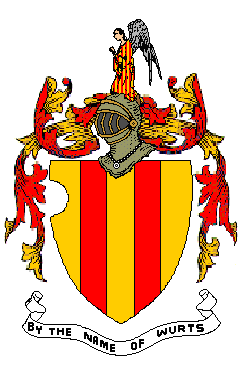

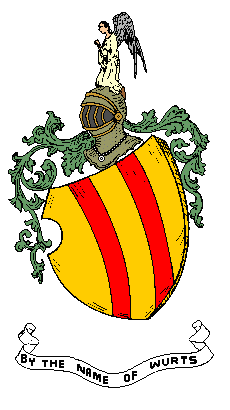
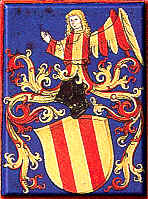 From the Grant of Arms
Image credit: http://wirzbald.ch/wirz-von-erlenbach.html
From the Grant of Arms
Image credit: http://wirzbald.ch/wirz-von-erlenbach.html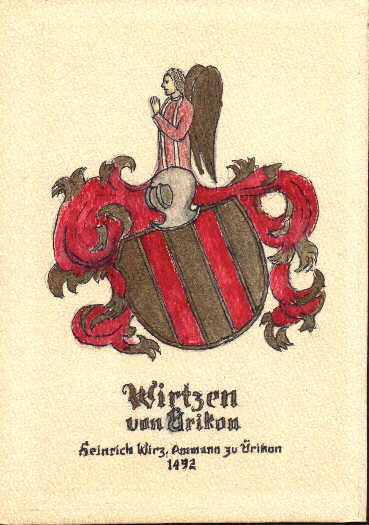
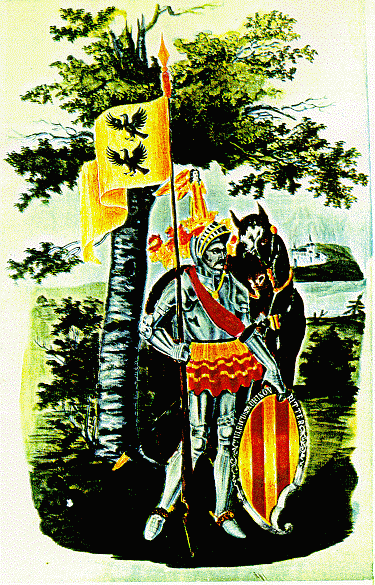
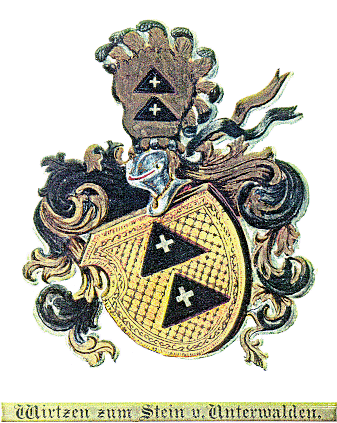 Wirtz zum Stein von Unterwalden
Wirtz zum Stein von Unterwalden